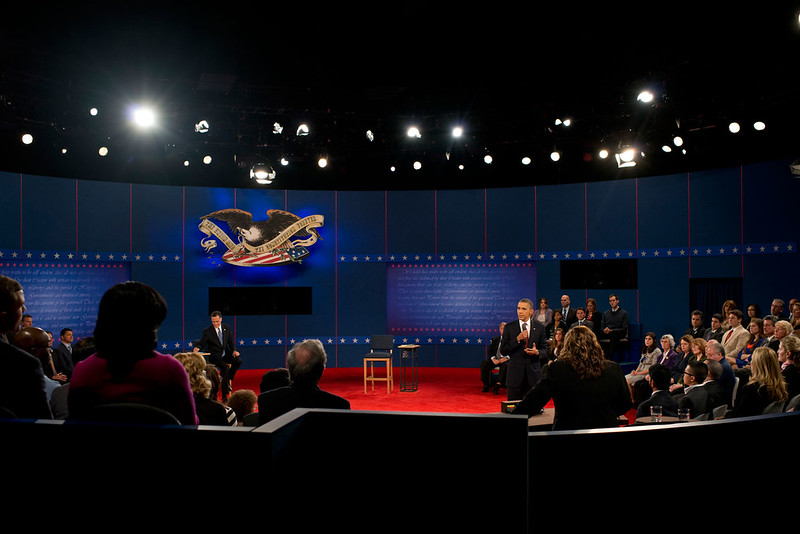Too many questions of concern to women and feminists go unasked at presidential debates. In advance of tonight’s presidential debate, we have some suggestions for the moderators.
Below are seven questions we hope will be asked at the next debate. Let us know what additional questions you have for the candidates—share them with the hashtag #TellMs and tag us @MsMagazine on Twitter!

#1: What will each candidate do to finally ratify the Equal Rights Amendment?
“Equality of rights under the law shall not be denied or abridged by the United States or by any State on account of sex.” This 24-word amendment was first proposed in 1923, but it did not pass Congress until 1972 when it was sent to the states for ratification.
Today, 37 of the necessary 38 states have voted to ratify the ERA, and more than 90 percent of Americans support women’s constitutional equality and are surprised to find the ERA has yet to be added to the Constitution. The House Judiciary Committee has advanced legislation to lift the arbitrary deadline on ratification of the Amendment, and Virginia’s 2019 election results left feminists optimistic that it will ratify next.
#2: How will each candidate protect against the further erosion of access to legal abortion and birth control?
Access to legal abortion, and even birth control, has always been a critical issue for women that doesn’t receive enough attention on the national stage. But it’s become an even more critical issue in the 2020 election: Virtual bans on abortion passed by some state legislatures could lead to criminal prosecution of women and their doctors, and the Supreme Court is poised to further restrict the right to abortion.
#3: What will each candidate do to address the epidemic of gender-based violence?
We know the statistics: One in four women will experience severe violence by an intimate partner in her lifetime, and one in five women will be raped.
Yet Republicans in the Senate have blocked efforts to reauthorize the Violence Against Women Act funding programs to address violence, or close loopholes in federal law prohibiting domestic abusers from purchasing and possessing guns. Under President Trump, the Department of Education has weakened its enforcement of Title IX as a way to address sexual assault on college and high school campuses across the country, and the Justice Department has eliminated domestic violence as grounds for asylum in violation of international and U.S. law.
#4: What will each candidate do to protect Afghan women’s rights?
All of the candidates have talked about reducing or withdrawing troops in Afghanistan. Afghan women have been clear: they want an end to the war, but they don’t want to go back to the lives they were forced to live under Taliban rule, and they want to be engaged in the future of their country.
In 2018, Congress passed the Women, Peace and Security Act requiring women’s participation at peace talks and in the implementation of peace agreements; experience shows that when women are at the negotiating table the likelihood that a peace agreement will last long term increases by as much as 35 percent. Yet in Afghanistan, the U.S. has focused its attention on negotiations with the men of the Taliban, which largely exists as a hit-and-run operation and which controls areas where only 3 percent of Afghans live. The talks have so far not included either women or representatives from the democratically elected Afghan government.
The Taliban has been explicit that they would neither recognize the legitimacy of the Afghan constitution nor its provisions for women’s equal rights. Afghan women fear that a return of the Taliban to a key role in governance of their country will threaten the tremendous progress women and girls have made since the fall of the Taliban. Girls have returned to school and university by the millions, and women are now lawyers and doctors and police officers and business owners and political leaders at the local and national levels.
#5: What will be each candidate’s top priorities in securing workplace equality for women?
The traditional measure of the wage gap finds that nationally, women overall are paid 80.5 cents for every dollar a white man is paid, with black women receiving only 63 cents and Latinas only 54.
But looking at only a snapshot of monthly or annual wages does not paint the full picture—because it fails to capture gender differences in benefits like pension contributions, employer provided insurance, paid leave, disability insurance and commissions and bonuses. Using this broader income calculation, today women receive only 57 cents to a man’s dollar, with the disparities worse for women of color.
Closing the income gap would cut in half the poverty rate among working women from 8 to 3.8 percent, and 2.5 million children would no longer live in poverty.





